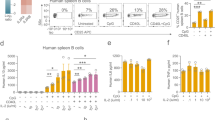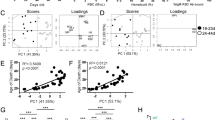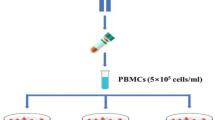Abstract
Acquired aplastic anemia (AA) is an autoimmune disease characterized by hematopoietic stem and progenitor cell destruction in bone marrow. The non-classic human leukocyte class I antigen (HLA-) G interacts with multiple cell subsets, such as T cells and B cells. HLA-G exerts powerful immune suppression by binding with its receptors, immunoglobulin-like transcripts (ILTs). Here, we compared 46 AA patients and 28 healthy controls. Soluble HLA-G levels in bone marrow supernatants from AA patients were higher than controls. The proportion of bone marrow B cells was decreased and the ILT2-expressing cells among CD19+ cells were increased in AA patients. In addition, the percentage of mature B cells among marrow B cells was increased in AA patient, while the percentage of pro-B plus pre-B cells was decreased. More immature B cells and pro-B plus pre-B cells expressed ILT2 in AA patients than in controls, while mature B cells expressing ILT2 did not differ significantly. Functional studies demonstrated that high-level soluble HLA-G inhibited bone marrow B cell proliferation by interacting with ILT2 in AA, and was blocked by anti-HLA-G and anti-ILT2 monoclonal antibodies. Together, these results suggest that the abnormal decrease of pro-B plus pre-B cells in AA patients was related to the enhanced suppression by the excess HLA-G and ILT2 proteins. Therapeutic blockade of the HLA-G-ILT2 interaction may help to normalize bone marrow B cell proliferation.




Similar content being viewed by others
Data availability
All data generated or analyzed during this study are included in this article.
Code availability
Not applicable.
References
de Latour RP, Visconte V, Takaku T, Wu C, Erie AJ, Sarcon AK, Desierto MJ, Scheinberg P, Keyvanfar K, Nunez O, Chen J, Young NS (2010) Th17 immune responses contribute to the pathophysiology of aplastic anemia. Blood 116(20):4175–4184. https://doi.org/10.1182/blood-2010-01-266098
Young NS (2013) Current concepts in the pathophysiology and treatment of aplastic anemia. Hematology Am Soc Hematol Educ Program 2013:76–81. https://doi.org/10.1182/asheducation-2013.1.76
Shi J, Ge M, Lu S, Li X, Shao Y, Huang J, Huang Z, Zhang J, Nie N, Zheng Y (2012) Intrinsic impairment of CD4(+)CD25(+) regulatory T cells in acquired aplastic anemia. Blood 120(8):1624–1632. https://doi.org/10.1182/blood-2011-11-390708
Zeng Y, Katsanis E (2015) The complex pathophysiology of acquired aplastic anaemia. Clin Exp Immunol 180(3):361–370. https://doi.org/10.1111/cei.12605
Hirano N, Butler MO, Von Bergwelt-Baildon MS, Maecker B, Schultze JL, O’Connor KC, Schur PH, Kojima S, Guinan EC, Nadler LM (2003) Autoantibodies frequently detected in patients with aplastic anemia. Blood 102(13):4567–4575. https://doi.org/10.1182/blood-2002-11-3409
Feng X, Chuhjo T, Sugimori C, Kotani T, Lu X, Takami A, Takamatsu H, Yamazaki H, Nakao S (2004) Diazepam-binding inhibitor-related protein 1: a candidate autoantigen in acquired aplastic anemia patients harboring a minor population of paroxysmal nocturnal hemoglobinuria-type cells. Blood 104(8):2425–2431. https://doi.org/10.1182/blood-2004-05-1839
Goto M, Kuribayashi K, Takahashi Y, Kondoh T, Tanaka M, Kobayashi D, Watanabe N (2013) Identification of autoantibodies expressed in acquired aplastic anaemia. Br J Haematol 160(3):359–362. https://doi.org/10.1111/bjh.12116
Hirano N, Butler MO, Guinan EC, Nadler LM, Kojima S (2005) Presence of anti-kinectin and anti-PMS1 antibodies in Japanese aplastic anaemia patients. Br J Haematol 128(2):221–223. https://doi.org/10.1111/j.1365-2141.2004.05317.x
Takamatsu H, Feng X, Chuhjo T, Lu X, Sugimori C, Okawa K, Yamamoto M, Iseki S, Nakao S (2007) Specific antibodies to moesin, a membrane-cytoskeleton linker protein, are frequently detected in patients with acquired aplastic anemia. Blood 109(6):2514–2520. https://doi.org/10.1182/blood-2006-07-036715
Hao S, Zhang Y, Hua L, Xie N, Xiao N, Wang H, Fu R, Shao Z (2020) Antibodies specific to ferritin light chain polypeptide are frequently detected in patients with immunerelated pancytopenia. Mol Med Rep 22(3):2012–2020. https://doi.org/10.3892/mmr.2020.11280
Qi Z, Takamatsu H, Espinoza JL, Lu X, Sugimori N, Yamazaki H, Okawa K, Nakao S (2010) Autoantibodies specific to hnRNP K: a new diagnostic marker for immune pathophysiology in aplastic anemia. Ann Hematol 89(12):1255–1263. https://doi.org/10.1007/s00277-010-1020-3
Curigliano G, Criscitiello C, Gelao L, Goldhirsch A (2013) Molecular pathways: human leukocyte antigen G (HLA-G). Clin Cancer Res 19(20):5564–5571. https://doi.org/10.1158/1078-0432.CCR-12-3697
Carosella ED, Favier B, Rouas-Freiss N, Moreau P, Lemaoult J (2008) Beyond the increasing complexity of the immunomodulatory HLA-G molecule. Blood 111(10):4862–4870. https://doi.org/10.1182/blood-2007-12-127662
LeMaoult J, Zafaranloo K, Le Danff C, Carosella ED (2005) HLA-G up-regulates ILT2, ILT3, ILT4, and KIR2DL4 in antigen presenting cells, NK cells, and T cells. FASEB J 19(6):662–664. https://doi.org/10.1096/fj.04-1617fje
Bahri R, Hirsch F, Josse A, Rouas-Freiss N, Bidere N, Vasquez A, Carosella ED, Charpentier B, Durrbach A (2006) Soluble HLA-G inhibits cell cycle progression in human alloreactive T lymphocytes. J Immunol 176(3):1331–1339. https://doi.org/10.4049/jimmunol.176.3.1331
Caumartin J, Favier B, Daouya M, Guillard C, Moreau P, Carosella ED, LeMaoult J (2007) Trogocytosis-based generation of suppressive NK cells. EMBO J 26(5):1423–1433. https://doi.org/10.1038/sj.emboj.7601570
Rouas-Freiss N, Marchal RE, Kirszenbaum M, Dausset J, Carosella ED (1997) The alpha1 domain of HLA-G1 and HLA-G2 inhibits cytotoxicity induced by natural killer cells: is HLA-G the public ligand for natural killer cell inhibitory receptors? Proc Natl Acad Sci USA 94(10):5249–5254
Contini P, Ghio M, Poggi A, Filaci G, Indiveri F, Ferrone S, Puppo F (2003) Soluble HLA-A,-B,-C and -G molecules induce apoptosis in T and NK CD8+ cells and inhibit cytotoxic T cell activity through CD8 ligation. Eur J Immunol 33(1):125–134. https://doi.org/10.1002/immu.200390015
Fournel S, Aguerre-Girr M, Huc X, Lenfant F, Alam A, Toubert A, Bensussan A, Le Bouteiller P (2000) Cutting edge: soluble HLA-G1 triggers CD95/CD95 ligand-mediated apoptosis in activated CD8+ cells by interacting with CD8. J Immunol 164(12):6100–6104
Morandi F, Rouas-Freiss N, Pistoia V (2014) The emerging role of soluble HLA-G in the control of chemotaxis. Cytokine Growth Factor Rev 25(3):327–335. https://doi.org/10.1016/j.cytogfr.2014.04.004
Ristich V, Liang S, Zhang W, Wu J, Horuzsko A (2005) Tolerization of dendritic cells by HLA-G. Eur J Immunol 35(4):1133–1142. https://doi.org/10.1002/eji.200425741
LeMaoult J, Krawice-Radanne I, Dausset J, Carosella ED (2004) HLA-G1-expressing antigen-presenting cells induce immunosuppressive CD4+ T cells. Proc Natl Acad Sci USA 101(18):7064–7069. https://doi.org/10.1073/pnas.0401922101
Naji A, Le Rond S, Durrbach A, Krawice-Radanne I, Creput C, Daouya M, Caumartin J, LeMaoult J, Carosella ED, Rouas-Freiss N (2007) CD3+CD4low and CD3+CD8low are induced by HLA-G: novel human peripheral blood suppressor T-cell subsets involved in transplant acceptance. Blood 110(12):3936–3948. https://doi.org/10.1182/blood-2007-04-083139
Naji A, Menier C, Morandi F, Agaugue S, Maki G, Ferretti E, Bruel S, Pistoia V, Carosella ED, Rouas-Freiss N (2014) Binding of HLA-G to ITIM-bearing Ig-like transcript 2 receptor suppresses B cell responses. J Immunol 192(4):1536–1546. https://doi.org/10.4049/jimmunol.1300438
Negrini S, Contini P, Pupo F, Greco M, Murdaca G, Puppo F (2020) Expression of membrane-bound human leucocyte antigen-G in systemic sclerosis and systemic lupus erythematosus. Hum Immunol 81(4):162–167. https://doi.org/10.1016/j.humimm.2019.12.004
Rizzo R, Farina I, Bortolotti D, Galuppi E, Rotola A, Melchiorri L, Ciancio G, Di Luca D, Govoni M (2013) HLA-G may predict the disease course in patients with early rheumatoid arthritis. Hum Immunol 74(4):425–432. https://doi.org/10.1016/j.humimm.2012.11.024
Contini P, Murdaca G, Puppo F, Negrini S (2020) HLA-G expressing immune cells in immune mediated diseases. Front Immunol 11:1613. https://doi.org/10.3389/fimmu.2020.01613
Catamo E, Addobbati C, Segat L, Sotero Fragoso T, Domingues Barbosa A, Tavares Dantas A, de Ataide Mariz H, F da Rocha L Jr, Branco Pinto Duarte AL, Monasta L, Sandrin-Garcia P, Crovella S (2014) HLA-G gene polymorphisms associated with susceptibility to rheumatoid arthritis disease and its severity in Brazilian patients. Tissue Antigens 84(3):308–315. https://doi.org/10.1111/tan.12396
Rizzo R, Rubini M, Govoni M, Padovan M, Melchiorri L, Stignani M, Carturan S, Ferretti S, Trotta F, Baricordi OR (2006) HLA-G 14-bp polymorphism regulates the methotrexate response in rheumatoid arthritis. Pharmacogenet Genomics 16(9):615–623. https://doi.org/10.1097/01.fpc.0000230115.41828.3a
Bae SC, Lee YH (2021) Association of HLA-G polymorphisms with systemic lupus erythematosus and correlation between soluble HLAG levels and the disease: a meta-analysis. Z Rheumatol 80(1):96–102. https://doi.org/10.1007/s00393-020-00783-6
Camitta BM, Thomas ED, Nathan DG, Santos G, Gordon-Smith EC, Gale RP, Rappeport JM, Storb R (1976) Severe aplastic anemia: a prospective study of the effect of early marrow transplantation on acute mortality. Blood 48(1):63–70
Loken MR, Shah VO, Hollander Z, Civin CI (1988) Flow cytometric analysis of normal B lymphoid development. Pathol Immunopathol Res 7(5):357–370
Ghia P, ten Boekel E, Rolink AG, Melchers F (1998) B-cell development: a comparison between mouse and man. Immunol Today 19(10):480–485
Li X, Xu F, He Q, Wu L, Zhang Z, Chang C (2010) Comparison of immunological abnormalities of lymphocytes in bone marrow in myelodysplastic syndrome (MDS) and aplastic anemia (AA). Intern Med 49(14):1349–1355
Naji A, Menier C, Maki G, Carosella ED, Rouas-Freiss N (2012) Neoplastic B-cell growth is impaired by HLA-G/ILT2 interaction. Leukemia 26(8):1889–1892. https://doi.org/10.1038/leu.2012.62
Lamar DL, Weyand CM, Goronzy JJ (2010) Promoter choice and translational repression determine cell type-specific cell surface density of the inhibitory receptor CD85j expressed on different hematopoietic lineages. Blood 115(16):3278–3286. https://doi.org/10.1182/blood-2009-09-243493
Banham AH, Colonna M, Cella M, Micklem KJ, Pulford K, Willis AC, Mason DY (1999) Identification of the CD85 antigen as ILT2, an inhibitory MHC class I receptor of the immunoglobulin superfamily. J Leukoc Biol 65(6):841–845
Funding
This work was supported by grants from the National Natural Science Foundation of China (91942306, 81770133, 81800112), China Postdoctoral Science Foundation (2020M672075).
Author information
Authors and Affiliations
Contributions
All authors contributed to the study conception. J.P. designed the research, performed the research, analyzed the data, and wrote the paper; Y.-x.S. performed the research, analyzed the data, and wrote the paper; Q.F., S.-w.W., X.L., and Z.S. performed the research and analyzed the data. All authors read and approved the final manuscript.
Corresponding authors
Ethics declarations
Ethics approval
The research protocol was established according to the ethical guidelines of the Helsinki Declaration and was approved by the Medical Ethics Committee of Qilu Hospital, Shandong University.
Consent to participate
Written informed consent was granted by all participants.
Consent for publication
All participants signed informed consent regarding publishing their data.
Conflict of interest
The authors declare no competing interests.
Additional information
Publisher's note
Springer Nature remains neutral with regard to jurisdictional claims in published maps and institutional affiliations.
A portion of this study was presented under the title, “Aberrant Expression Profiles of HLA-G and Immunoglobulin-like Transcripts (ILTs) in Acquired Aplastic Anemia” (Abstract Code: P248) and awarded a travel grant at the 20th Congress of European Hematology Association in Vienna, Austria, June 11–14, 2015
Supplementary Information
Below is the link to the electronic supplementary material.
Rights and permissions
About this article
Cite this article
Sun, Yx., Feng, Q., Wang, Sw. et al. HLA-G-ILT2 interaction contributes to suppression of bone marrow B cell proliferation in acquired aplastic anemia. Ann Hematol 101, 739–748 (2022). https://doi.org/10.1007/s00277-022-04757-3
Received:
Accepted:
Published:
Issue Date:
DOI: https://doi.org/10.1007/s00277-022-04757-3




